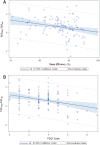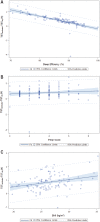Information on Bedtimes and Wake Times Improves the Relation Between Self-Reported and Objective Assessments of Sleep in Adults
- PMID: 31383241
- PMCID: PMC6622506
- DOI: 10.5664/jcsm.7888
Information on Bedtimes and Wake Times Improves the Relation Between Self-Reported and Objective Assessments of Sleep in Adults
Abstract
Study objectives: To investigate the correlation between self-reported and objective measures of total sleep time (TST) in adults and examine whether sex, race/ethnicity, and weight status influence this association.
Methods: Participants were individuals who screened for sleep intervention studies, providing > 7 days of wrist actigraphy sleep data (TSTobj) and reporting sleep duration (TSTPSQI) using the Pittsburgh Sleep Quality Index (PSQI) questionnaire (n = 53 men, 60 women; 59% minority/Hispanics; age 30.9 ± 9.7 years; body mass index 26.2 ± 3.2 kg/m2). In addition, TSTbed/wake was calculated as the difference between bedtime and waketime, minus the time to fall asleep, from the PSQI. Univariate regression analyses were performed to assess the relation between TSTobj and TSTPSQI and TSTbed/wake and compare the relation by sex, race, and ethnicity. Bland-Altman tests were done to assess bias by sex, race/ethnicity, weight status, and sleep quality.
Results: TSTbed/wake correlated with TSTobj (r = .57, P < .0001). TSTPSQI and TSTbed/wake were greater than TSTobj (0.63 ± 0.99 hours and 0.79 ± 0.76 hours, respectively, both P < .0001). The difference between TSTPSQI and TSTobj did not vary by sex (β = .12, P = .52), race/ethnicity (β = .15, P = .48), age (β = -.01, P = .27), or body mass index (β = .04, P = .13) whereas that between TSTbed/wake and TSTobj varied by age (β = -.020, P = .0051), BMI (β = .054, P = .0021), race/ethnicity (β = .36, P = .021), and sleep efficiency (β = -.089, P < .0001).
Conclusions: Calculating TST using self-reported bedtimes and wake times provided TST estimate that correlated with TSTobj but greater over-reporting occurred in younger and heavier individuals, non-whites or Hispanics, and those with low sleep efficiency. In clinical and research settings, asking individuals to report bedtimes, wake times, and length of time to fall asleep may more accurately estimate TST than asking about sleep duration alone.
Keywords: Pittsburg Sleep Quality Index; actigraphy; sleep duration; subjective sleep.
Copyright © 2019 American Academy of Sleep Medicine. All rights reserved.
Figures



References
-
- Jackowska M, Ronaldson A, Brown J, Steptoe A. Biological and psychological correlates of self-reported and objective sleep measures. J Psychosom Res. 2016;84:52–55. - PubMed
-
- Buysse DJ, Reynolds CF, 3rd, Monk TH, Berman SR, Kupfer DJ. The Pittsburgh Sleep Quality Index: a new instrument for psychiatric practice and research. Psychiatry Res. 1989;28(2):193–213. - PubMed
Publication types
MeSH terms
Grants and funding
LinkOut - more resources
Full Text Sources
Medical

